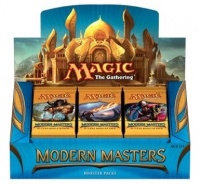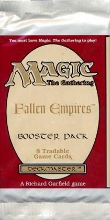 Rolling for Initiative is a weekly column by Scott Thorne, PhD, owner of Castle Perilous Games & Books in Carbondale, Illinois and instructor in marketing at Southeast Missouri State University. This week, Thorne looks at Magic: The Gathering--Modern Masters, a hit.
Rolling for Initiative is a weekly column by Scott Thorne, PhD, owner of Castle Perilous Games & Books in Carbondale, Illinois and instructor in marketing at Southeast Missouri State University. This week, Thorne looks at Magic: The Gathering--Modern Masters, a hit.Well, the highly anticipated set of Magic: The Gathering--Modern Masters (see "'Magic: The Gathering--Modern Masters'") hit the shelves this week and sales have been, well, pretty good, to say the least, with most stores that did not limit quantities reporting rapid sellouts, even at above retail price. Prior to release, I saw a number of stores online preselling boxes on Amazon for upwards of $240, roughly a 40% price premium. Of course, retailers are complaining about the limited quantity of the product and forgetting about the law of supply and demand. Remember that one? When supply is limited on a highly desirable product, demand pushes the price up, a basic law of economics mirroring human behavior. If retailers could have ordered as much as we wanted of Modern Masters, retailers would have satisfied customer demand and we still wouldn't have customers clamoring for and paying premium prices for Modern Masters. Got me thinking about the release of Fallen Empires back in 1994.
Long time game store retailers still remember the release of the Fallen Empires set. Prior to Fallen Empires, retailers had played the allocation shuffle with Magic releases. Since stores never got the quantity of Magic we expected we could sell we would put in orders of double or triple the quantity of Magic we wanted with multiple distributors, expected we would get allocated down to a quantity close to the quantity of product we could actually sell. While this kinda worked, it really distorted the supply chain so nobody had a good idea regarding actual sales figures or at what level supply would saturate demand. With Fallen Empires, we found out.
Wizards of the Coast warned retailers ahead of time that the company would print enough Fallen Empires to completely fill all orders, meaning we would get everything we ordered, no allocations this time. However, WotC had made the same announcements for previous sets as well and the supply released never came close to satisfying the demand for the product in the market. So, almost all retailers took this claim with a large shaker of salt and ordered expecting allocations again. Needless to say, with this set, WotC filled every order, leaving the market awash in Fallen Empires. Retailers started dumping excess orders, driving prices to the level that for years, you could find sealed booster displays of the set for $30 or thereabouts. Just like with Modern Masters, the law of supply and demand worked to set prices for the set at a level appropriate for the market.
I have also seen complaints about the design of the box due to its slanting design (see "Ted Yee of T&N Games on TCG Packaging"), which makes it awkward to store as it does not stack well. While true, it does feed the perception that manufacturers can never satisfy retailers who will always find some fault to complain about. With Modern Masters, essentially WotC has sold me $7 bills for $3.50, which works just find for me. Heck, for that kind of a deal, if WotC wanted to pack each Modern Master set of boosters in a little round ball that rolls off the shelf and, as long as demand keeps up, I would happily let them roll all over the floor of the stockroom as I don't expect it to stay here long enough for it to cause a problem. WotC's basically selling me money. I am happy to take it.
The opinions expressed in this column are solely those of the writer, and do not necessarily reflect the views of the editorial staff of ICv2.com.








